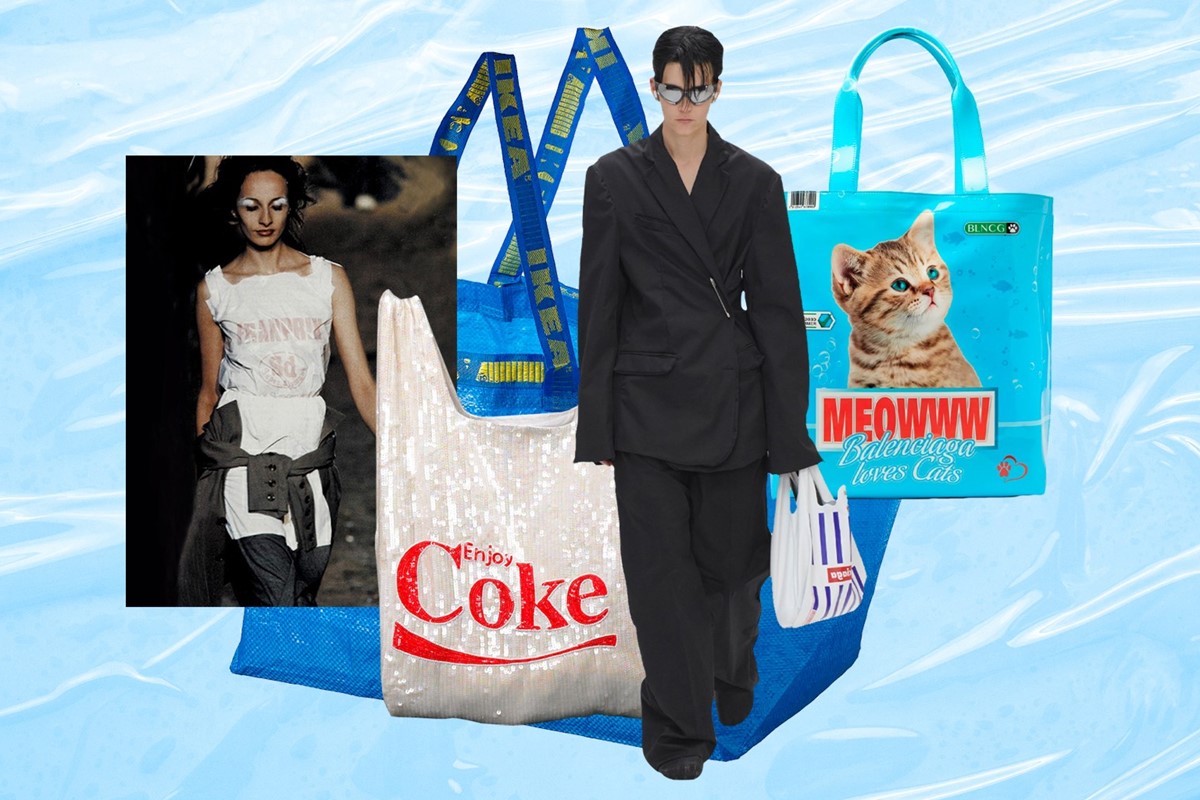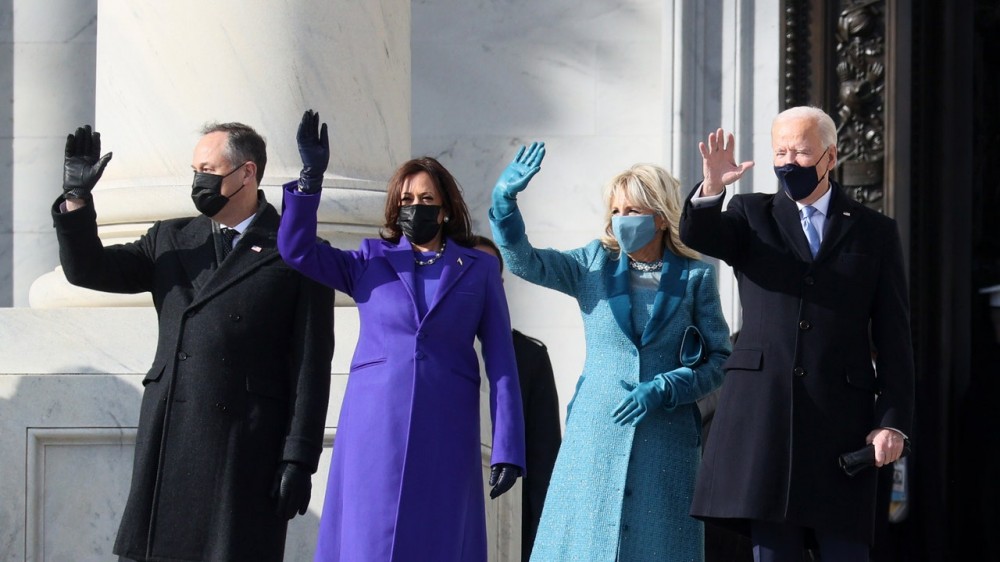

Plastic fantastic? Tracing fashion’s obsession with the carrier bag
SS22 saw Balenciaga reinvent the humble shopping bag as part of an aisle-to-runway crossover – but it’s not the first time the unassuming item has transfixed the industry
Few objects are as flimsy as the plastic bag. As pop-philosopher Katy Perry once noted, they, like us, drift through the wind aimlessly, a literal throwaway item destined to be snagged on rotting tree branches or crammed into an under-the-sink Russian doll of their counterparts. In fashion, however, the object is regarded with the kind of fascination usually afforded to more luxurious pieces, popping up incongruously on catwalks around the world as designers put their spin on the unlikely style icon – the results of which unsurprisingly rake in far more cash than the everyday 5p variety.
Having previously riffed on Ikea’s behemoth ‘Frakta’ shopper back in 2017, just a few weeks ago, Balenciaga’s mischievous designer Demna Gvasalia secured the bag yet again. In a show consisting of deepfake audiences, stiletto crocs and Gucci hacks, they might have gone unnoticed, but the eager-eyed among us clocked them swinging down the runway straight away, emblazoned with poppy, vertical lines riffing on Tesco’s old-school carriers. Forget the Baguette: this bad boy could’ve carried one.




While the 3D-printed shoes and CGI crowds were as futuristic as it comes, it goes without saying that life in plastic isn’t so fantastic. High-density polythene – the material used to make plastic bags – was first synthesised way back in 1953. In 1965, Swedish company Celloplast obtained a US patent for engineer Sten Gustaf Thulin’s standard silhouette, later dubbed ‘the t-shirt plastic bag’ for its punched-out holes. By 1979, 80 per cent of shopping bags dished out in Europe were plastic; by the 1980s they were as omnipresent as gobbets of chewing gum on pavements, replacing the paper bag with the voracity of the grey squirrel.
It didn’t take too long for what was usually found in the aisles to land on the catwalk. For his 1990 show, Maison Margiela turned Franpix bags into tops; four years later, the motif returned when the runway was installed in an abandoned supermarket. By the time we hit the 2010s, the plastic bag was taking over. Chanel transformed 500 supermarket products into redesigned items for its AW14 show, punnily labelling a bin bag (sac poubelle) as a ‘more beautiful bag’ (sac plus belle). A year later, Christopher Shannon printed Tesco-style bags on oversized sweaters, later reviving this vibe for SS17 with a ‘Lovers Direct’ bag parodying Mike Ashley’s sports juggernaut.
Meanwhile inner-city streets were awash with the likes of Jil Sander’s orange market bag and Celine’s see-through shopper, blending in with (just slightly) cheaper supermarket real deals. The most memorable of these designer bags – and closest to the actual thing – was cult London label Ashish’s series of supermarket carriers, dappled in sequins and emblazoned with twisted brand names; ‘Tesco’ was warped into ‘Disco’, while ‘M&S’ blasphemously became ‘S&M’.
“I’d been wanting to do a version of the Ikea bag for a few years and then never did it because of copyright,” founder Ashish Gupta remembers. “Then, when I was doing SS14, I did a collaboration with Coca-Cola… I was really interested by the idea of Coca-Cola being this American symbol of democracy, and Andy Warhol had this piece about how Coca-Cola is very democratic because no matter who drank it, it always tasted the same.”
loving these Ashish sequin 'plastic' bags pic.twitter.com/2ujcAJe6yY
— I heart NYC (@IheartNYC12) May 9, 2014
This mass-market appeal is why Instagram went into meltdown when Rihanna was pictured with a Sainsbury’s Bag for Life: an everyday, throwaway object brings groundedness into high fashion, something almost always remiss. “Because fashion is so often seen in a bit of a bubble and it’s aspirational, it’s quite funny if you reach out and pick up things that are very common objects, very democratic, because fashion isn’t really democratic,” Gupta says. Nothing, after all, is more universal than a plastic bag. “When I actually started looking at them, I realised it’s one of those things you take for granted – you don’t ever really look at it, you just take it.”
At the same time in Berlin, Thibaud Guyonnet, head buyer at Voo Store, oversaw the store’s own plastic bag with Raf Simons. ‘We were just at the Raf showroom and we saw a sample similar to (the Celine version),” he reminisces. “Usually in showrooms a large number of the items are not actually produced (for retail), and I think back then no one was really interested in buying that bag but we really loved it, so we said, ‘Hey guys, why don’t we just release it at Voo?’ We took the whole stock.” As with Ashish, it fitted Voo’s penchant for remixing the quotidian. “I think that’s something we always liked, to play on an item that is so democratic and every single person is using,” Guyonnet says. “It’s pure branding, you want to have your logo on an item that’s very functional. From our side, we in Germany are the country that loves functionality.”


While the Raf Simons collaboration was eye-drenchingly expensive – its €198 price tag induced what Guyonnet calls a ‘mini shitstorm’ and zero sales for two months before some lifesaving press in Korea – Voo’s own plastic shopper is a hero piece. “It’s such a basic, basic item but it’s very useful and an inclusive item somehow. (The bags) are about €10; for us it was really important to have that one product that anyone could buy, and somehow you can belong to the community even if you have a smaller budget. Students were happy to buy (them) and walk around with the Voo Bag.”
While plastic bags were taking off in fashion, they hit a roadblock in the real world. In 2015, the UK brought in a mandatory fee of 5p, aiming to cut down on the dizzying amount thrown away every single year. Environmental concerns turned a single-use item into a paid-for commodity, thrusting the object into a new era. Totes reigned supreme, seeing supermarkets rapidly fill up with more hemp than you’d find in the whole of Bristol and a 5p increase in the fee this year going unchallenged.
“It’s ironic, but (plastic bags) were originally meant to help save the planet. People were using so many paper bags that it was leading to deforestation, so they thought it was very clever to invent this bag that was going to save the world” – Ashish Gupta
This sea change in perception saw Arielle Sidney, who went viral on TikTok earlier this year for her ingenious upcycled creations, turn to reusing carrier bags. “I wanted to recycle and a lot of carrier bags get thrown away,” she says over Zoom from California. “I thought I’d find a way to make it more useful, so fashion was the way I found to do it. It shows the world that it is possible to reuse things. It doesn’t have to be something ridiculous; it can be something as simple as upcycling an old bag into another object to wear out.” The hype quickly spread, and Arielle’s home quickly transformed into a pop-up recycling hub. “Lots of people wanted to send me their bags so I could make things out of them! It was really funny.”
While upcycling may prove a more tasteful way of reevaluating the plastic bag, there’s a more challenging argument to be made: that they aren’t, intrinsically, quite as bad as everyone thinks. After all, Sten Gustaf Thulin originally intended for his bags to be reused. “It’s ironic, but they were originally meant to help save the planet,” Gupta explains. “People were using so many paper bags that it was leading to deforestation, so they thought it was very clever to invent this bag that was going to save the world.” While it may have proved disastrous, it’s still an important cultural curio: “Actually, it’s a very beautifully designed object. It’s seamless, the handles are integrated into the design – it’s actually a very clever little piece of design.”
@ariellesidney_ Let’s pretend I’m famous and get this video on the fyp 🙂 ##WellDone ##ShowUpShowOff ##vans ##vansoffthewall ##fashion ##expressieyourself
♬ positions – Ariana Grande
Although Guyonnet remembers that “as a kid going on the motorway, you’d have plastic bags flying everywhere, it was gross’, he too holds a slight soft spot for them. “I think the object itself has changed anyway,” he argues, “because we don’t really have those single-use bags, they’ve actually become something that you keep. We (Voo Store) looked at different options that were more sustainable, and actually some reusable plastic bags are more sustainable than using recycled paper, for example… Somehow, the plastic bag is not as evil as it was a few years back.” For Guyonnet, there are no qualms about heading out with one: “When I find a nice plastic bag, I totally keep it and I’m happy to walk down the street with it!”
When you consider the inventor’s wish to create a democratic, environmentally friendly product, it’s hard not to ever-so-slightly romanticise the good intentions that lay behind the plastic bag’s creation. Even if they’re fucking with us, there’s a small comfort in seeing houses like Balenciaga embrace it, making us feel a tad more stylish when we rush out with one that’s been scrunched up under the kitchen sink. Perhaps last decade’s small runs of high-priced, luxury versions helped draw attention to the object’s value, encouraging people, as once intended, to reuse them frequently rather than toss them away. One thing’s for sure when it comes to fashion: they will never be seen as an unexpected item in the backstage area again.





